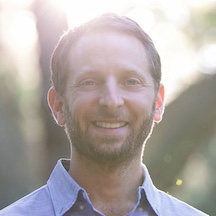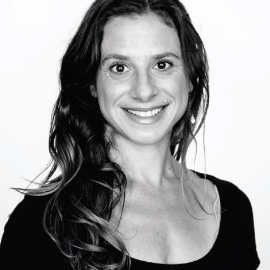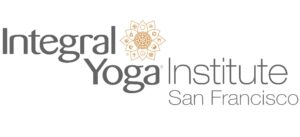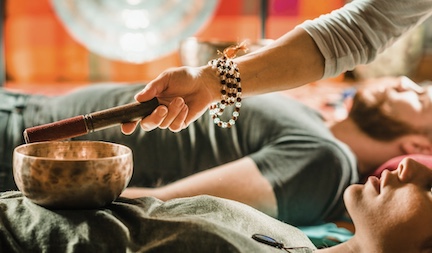By Rachel Jennine Goudey, Psy.D., C-IAYT and Shalom Mayberg, MIM
Just because we can, doesn’t mean we have to, or that we should. I recognize this ingrained “need” within myself to always do more, go hard, say “yes.” I notice it when I feel overwhelmed by an upcoming social event or task that I said “yes” to, but my body is telling me “no,” and asking for rest, and I wrestle with what to do. I notice it physically when I take a yoga class and the teacher invites us to go slower, to skip the vinyasa and go straight to downward dog or child’s pose and rest in the stillness longer. Often I continue to practice the vinyasa, though more and more I’m encouraging myself to take the pause, do a little less and thus be able to really settle into my body and BE there. This is what creates space, and in turn, cues us into what our true capacity is.
Capacity can be defined as how much we can hold, as well as how much we can produce. Knowing what our capacity to take in, as well as what our capacity is to put out is, only comes when we allow ourselves the space to pause and listen. By listen, I mean feel, and this happens when our body can let go and relax. Like everything else though, it is a daily practice of pausing and noticing. Getting curious, and being kind. If we are not used to going slow and relaxing, it can actually feel tense and scary. Our body and nervous system need time to adjust to something different. This is where the practices of slower, therapeutic Yoga like restorative and yin can help us as they encourage us to soften and slow down progressively. The postures, held for lengths of time in a supportive environment, with supportive props teach our nervous system that it is not only safe, but healthy for us to slow down. In time this message translates into our daily lives and we begin to make more conscious choices that honor our body, energy, and mind’s true capacities.
In a recent restorative class where I was the student, the teacher guided us into a supportive bridge pose, encouraging us to put the block on the lowest height. I always put the block on the highest height because my body can comfortably do that, and “if I do less, I won’t get enough out of it.” Perhaps what there is to “get out of it” is to learn to be patient and present with one’s self, and give some space for ease. I turned the block to its lowest height. I watched myself physically and mentally struggle a bit to get comfortable. After a bit, with my attention on my breath and giving permission to do less, my body and mind calmed and I settled into ease.
Like restorative yoga, the benefits of therapeutic sound healing are apparent when we slow down and let go of trying so hard. Sound healing has this way of inviting us on a journey through the senses whereby we can release, heal, or acknowledge all sorts of life’s challenges. Emotional, physical, or spiritual ailments are released with each note of musical healing instruments. However, the precursor to this is “letting go” letting go of judgments, or preconceived ideas of how this or that should be or at a minimum, a willingness to let go- aka a willingness to change. For some, during a therapeutic sound bath letting go happens very quickly, and for others, it takes a little bit more time. Each instrumental sound touches each person differently and offers the participant exactly what they need at that moment.
One of the beautiful things about sound healing is that even in a group of 10 or 20 or more, all listening to the same sounds, each person will receive the sound differently and exactly as they need. One might see extravagant colors and multifaceted imagery bringing them to a state of grace and awe, while another might have a more visceral experience, akin to an energetic, chiropractic adjustment of sorts, while another might be remembering and releasing old hurts through whimpers and tears. At its core, however, therapeutic sound healing will bring us back to our center and realign our energetic (chakras and meridians) system to a place of presence offering us clarity and a deeper connection.
The sound vibrations pulse through the physical body while the Yoga postures target specific fascia and muscles, offering each cell, organ, muscle, and bone an acoustic massage from the inside out. Ultimately, this massage-like experience brings the brain and subtle body to a place of stillness. It is from this place of stillness that the inert wisdom can come alive to restructure and realign itself.
Often we don’t realize all the ways we are constantly doing, and overriding our capacity, be it energetically, mentally, emotionally, or physically as it becomes “normal,” and we fall into patterns of running our body and nervous system beyond their capacity. This is when things like burnout, fatigue, overwhelm, and feeling paralyzed to take action come into play. Harnessing the ancient wisdom and power of Therapeutic Yoga and Sound Healing helps to realign the body, mind, and spirit and guide us to make conscious and aligned choices that honor our capacity in life.
You can experience Therapeutic Yoga and Sound Healing on Sunday, March 17 @ 3:30 pm – 5:30 pm PDT with Shalom and Rachel. Space is limited, please sign up in advance.
 Shalom Mayberg, MIM
Shalom Mayberg, MIM
Dedicated to holistic well-being and spiritual exploration, Shalom Mayberg is a yoga instructor, energy healer, and sound healing practitioner. Through the practice of yoga, he guides individuals on a mindful journey through movement, breath, and self-awareness harmonizing the body, mind, and soul. Shalom has also been working in the healing arts for over 13 years and uses modalities such as Reiki, Energy Medicine, and Intuition to facilitate holistic healing. In addition, the medicine of sound is prominent in his practice and is used to create transformative experiences for people of all backgrounds. Shalom recently graduated from the Academy of Intuition Medicine and offers 1:1 work, training in Reiki and sound healing, and group events. To learn more, visit shalom360.com.
 Rachel Jennine Goudey, Psy.D., C-IAYT
Rachel Jennine Goudey, Psy.D., C-IAYT
Rachel Rachel is an IAYT Certified Yoga Therapist, Educator and Doctor of Psychology. Specializing in trauma work and embodied practices for nervous system integration, Rachel helps clients increase their capacity for joy and love in life through somatic movement, breath work, sound healing, self-reflection, and cultivating healthy life choices.
Rachel brings years of mental health experience working with at-risk and underserved populations, integrating Eastern and Western practices to help clients move past symptom relief into true healing. She has brought holistic yoga programs and professional trainings on yoga for mental health into community mental health centers, hospitals and schools. Rachel’s aim is to guide individuals into states of peace and trust in their life’s story through the mind and body, create community, and bring the teachings and practices of yoga into various settings around the world. Rachel’s classes meet each student where they are at while still challenging them to reach new heights of self-realization, acceptance, and strength and flexibility, both on and off of the mat. She will push you to challenge yourself while also guiding you to listen to your body and intuition, teaching from a place of authenticity, passion and playfulness. To learn more about Rachel and her work visit racheljenninewellnessandyoga.co

